Hugh MacLeod of gapingvoid art gave Todd inspiration for this summer's book reviews when he said "Attach emotion to logic and anything is possible" – a common thread in the four books Todd reviews.

For me, May was both a short month (weeklong family vacation in Hawaii!) and a hectic month (very long hours, getting client projects and internal tasks ready for me to be away for a week)! Knowing that the June e-newsletter is traditionally our "Summer Book Reviews," my Business Development Associate and I had already decided in May the four books I planned to review. (Of course, at that time, I'd only read one of them ... sigh ... )
What had eluded both of us was a unifying theme connecting all four books. I usually have insights like that while on vacation, yet this year nothing came to me.
Fortunately, my first day back at work following vacation, one of my favorite newsletters arrived with a FANTASTIC title and some INCREDIBLE commentary!
Hugh MacLeod, of gapingvoid art, is an artist with a clever business model – draw something everyday (most often, the theme is business-related), write some commentary on the thoughts behind the drawing, send out the drawing and commentary FREE, and then count on people clicking through to purchase the drawing. Genius!
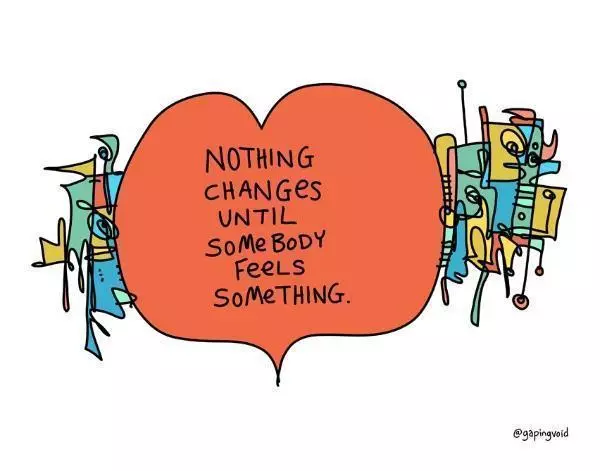
Hugh's theme that day was "Nothing Changes Until Somebody Feels Something."
One thing stood out in Hugh's comments:
"Attach emotion to logic and anything is possible."
So true!!
I like both the drawing and the title – to me, it's a play on "Nothing Happens Until Someone Sells Something." And isn't that what the best sales representatives do – attach emotion to logic? After all, until a person feels a strong emotion, the mind is really on auto-pilot, staying the course. Sure, you may have met with me to discuss a potential project for your business – but unless you're in REAL pain, it's unlikely logic alone will prompt you to say "Yes, let's get started."
Bringing this back around to the four books – the common thread is they ALL deal with developing an emotional connection with your clients or staff. And if you want your clients to prosper and your staff to grow, shouldn't you want to learn techniques to help you link emotion to logic? I hope so.
Make Your Point With Emotion
By Learning to Find and Tell Effective Stories
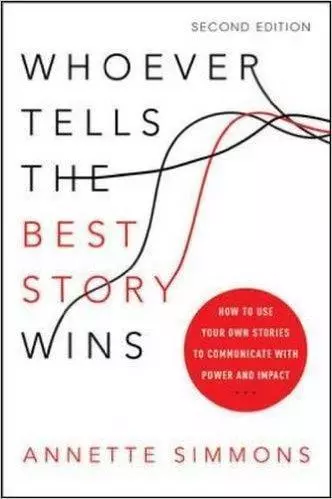
Whoever Tells The Best Story Wins: How to Use Your Own Stories to Communicate with Power and Impact (Second Edition)
by Annette Simmons
I figured this book would be a "winner" because (a) it is published by the American Management Association, which sets a VERY high bar for its publications, and (b) it is in its second edition. It was indeed a "winner"!
When I can tell a relevant story to address an issue that was previously not known – or, very often, known yet avoided – I've found I get better buy-in from prospects and clients.
The author describes the need for stories to help address paradoxes of modern life:
- Explosion of Choices – "The ocean of choice is only getting bigger, and we need the life preserver of meaningful stories more than ever." (page 4)
- Safety via Consistency – " ... our safety nets of algorithms, policies, scripts, and rules only support the illusion that consistency translates to quality. When it comes to emotions, consistency translates to apathy." (page 5)
Anyone who has ever made a sale knows facts and figures only go so far – unless the client feels pain or requires a gain, no deal will be inked. The author nails this truism when she writes:
- "Story thinking maps the emotional, cognitive, and spiritual world of feelings. For humans, feelings come first. We destroy facts we don't like and elevate lies that feel good." (page 11)
- " ... decisions that ignore emotions are easily ignored in return." (page 19)
Why are stories effective? The author's definition of "story" helps answer this question – a story is a "reimagined experience narrated with enough detail and feeling to cause your listeners' imaginations to experience it as real." (page 22) Once a listener can imagine what you're saying as real or possible, that listener sees you as being able to help her make the change you're proposing.
The book is pided into three parts:
- Part One: Thinking In Story begins to open the reader's eyes to the importance of stories in the workplace, and provides tips on how to identify your personal experiences which could be turned into a meaningful story. Four "buckets" of experiences are particularly good to sift for stories (pages 38-40):
- A time you shined
- A time you blew it
- A mentor
- A book, movie, or current event
- Part Two: Finding Stories to Tell discusses the six basic stories, and gives an example from all four "buckets" of experience for each of the six types. These six basic stories are:
- Who-I-Am Stories
- Why-I-Am-Here Stories
- Teaching Stories
- Vision Stories
- Value-in-Action Stories
- I-Know-What-You-Are-Thinking Stories
- Part Three: Perfecting the Craft offers tips on:
- Using Sensory Details, to make things more "real."
- Being Brief, to limit your stories to three minutes or less, and thus keep your listeners' attention.
- Avoiding Storytelling By Committee, to ensure emotions come through the story.
- Trying Different Points of View, to see how well a story works. One reason "The Parable of the Good Samaritan" (Luke 10:25-37) is so effective is because the story's point of view can be shifted among the traveler, the robbers who attacked the traveler, the two religious authorities who passed by the injured traveler, and the Samaritan who provided aid to the man.
- Listening to Stories, so you can improve your technique.
- Borrowing Freely, because many good sources of stories are readily available.
Even though I write and publish a story monthly (after all, what is my e-newsletter, other than a story about something I've seen or experienced ... ), I found many tips to write and tell stories more effectively. The biggest one – assess my stories for both sensory details and emotions triggered. A related insight – the e-newsletters receiving the largest number of comments from my readers have been those strong on details or emotions.
The author uses stories both long and short to make her points and illustrate the techniques she's describing, and these themselves are great examples to study and use! A different type of business book, for sure – yet one which is very valuable.
Hiding Behind Your PowerPoint
Zaps Emotion and Dilutes Your Impact
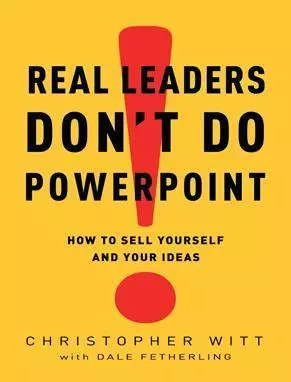
Real Leaders Don't Do PowerPoint: How to Sell Yourself and Your Ideas
by Christopher Witt with Dale Fetherline
Don't let the title of this book lead you to think it's not for you. Whether you're currently a leader or aspiring to be one, or just a person who is "tired of having your ideas dismissed while other people's ideas, less compelling than yours, win a better hearing and get a more positive response" (page 2), this book is for you.
The author has constructed the book around the four elements of a great speech, as formulated by Demosthenes, the father of Greek oratory. These elements are:
- A Great Person – The author stresses this includes everyone! What's required? "You have to be the best you you can be. So let your experience, passion, character, and even your sense of humor show up in every word you say and how you say it." (page 7)
- A Noteworthy Event – Not all events are worth your time.
- A Compelling Message – This is "nothing more – and nothing less – than an idea with the power to change people's lives, if only in a small way, expressed in the clearest, most compelling words." (page 7)
- A Masterful Delivery – While there are a number of techniques to help achieve this, all these merely serve the overall purpose of "projecting yourself – your authentic self – in the most powerful way possible." (page 7)
I'd read – and put to good use – this book many years ago! I'd forgotten how many pieces of good advice this book contains until I decided to include it in this review – when I brought it out to write about it, I saw I had highlighted or wrote margin notes on nearly EVERY page of the book.
Some items which stood out for me were:
- "You Only Have Three Speeches" – These boil down to the basic purpose of your talk – to identify, to influence, or to inspire. (page 19)
- Three Elements of a Compelling Message – These are a big idea (a single idea, not a multitude), a clear structure (keep it simple), and telling words (make your words count). (pages 76 and 77)
- Five Rhetorical Devices – Use these to give your speeches more power: The Rule of Three, Repetition, "Not This, But That" (compare and contrast), "It's Like" (simile or metaphor), and Rhetorical Question. (pages 78 through 80)
- "Chunk It" – The author refers to a "chunk" as the building blocks of speeches, and defines a chunk as two or more of the following: Claims, Evidence, Illustrations, and Audience Participation. (pages 101 through 107) I put chunking to work many years ago in two major ways – I overhauled my "Implementing the Big Picture" seminar into chunks, and began chunking my e-newsletter content for easier reading and use.
- Writing A Script – I'd always wondered why
- a good friend of mine, a retired pastor,
- wrote his talking points
- in an indented outline format – like this!
- wrote his talking points
- a good friend of mine, a retired pastor,
He'd been taught how to write out his points using the tips on pages 181 and 182!
- Making the Best Use of PowerPoint – When you need to use visual aids, follow the advice in this callout box (pages 214 and 215).
A few final good pieces of advice from near the end of the book:
- You "are the most important visual aid." (page 215)
- The three tests of a great speech, in today's environment, are "Results. Results. Results." (page 221)
- "Appeal to your listeners' emotions and intellect, to their imaginations and values." (page 221)
- "All is well if, when you're finished speaking, your listeners know and feel and do what you want them to do." (page 225)
This book is really a handbook chock full of tips and techniques, all aligned to one end – helping you give the best talk or presentation you can.
Create Loyal Customers Through
"Anticipatory Customer Service"
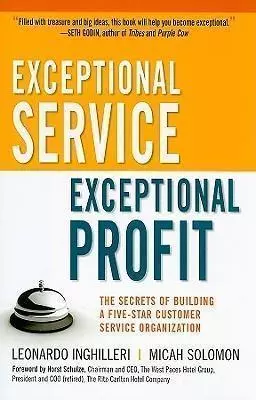
Exceptional Service, Exceptional Profit: The Secrets of Building a Five-Star Customer Service Organization
by Leonardo Inghilleri and Micah Solomon
Like every book I've ever read published by the American Management Association, this one is extraordinarily well-written and well-organized, and full of practical ideas.
The authors' goal is simple – provide ways to increase customer loyalty. Why is that important?
- The single best thing you can do for your business is to build true customer loyalty, one customer at a time. (page 1)
- Everything changes when a customer becomes a loyalist. To the truly loyal customer, you are the only shop in the marketplace. All the other brands and all the other vendors don't even come into focus. Like someone in love, the loyal customer only has eyes for you. (page 1)
Sounds great! How do you do that? You "turn your offering into much more than a commodity – you turn it into a personal relationship ... Escape this threat of commoditization by creating enduring, loyal, human relationships with customers." (page 2) The rest of the book goes on to describe techniques to achieve this.
While the book is not sub-pided into sections, I would organize them as follows:
- Section I – Setting the Stage (Chapters 1 and 2)
- Chapter 1 tells variations of the story "The Engineer on the Ladder" to illustrate degrees of customer satisfaction.
- Chapter 2 defines and describes the four elements of customer satisfaction: "Perfect Product, Caring Delivery, Timeliness, and an Effective Problem Resolution Process." (page 7)
- Section II – How to Build Personal Relationships (Chapters 3 through 6 and the Appendices)
- Chapter 3 focuses on "Language Engineering" – a term I'd never heard before – with the goal to ensure "Every. Word. Counts." The authors describe several companies which have codified their service philosophies and expectations, and have even gone so far to develop their own "lexicon" for words and phrases for their employees to use to help establish and build personal relationships. Examples of these philosophies, expectations, and lexicons are in Appendices A, B, and C.
- Chapter 4 describes techniques companies use to successfully turn around service failures, because these happen even to the best of us.
- Chapter 5 describes seven principles of noting and sharing customer roles and preferences, so employees can know these, anticipate customer needs, and be alert for opportunities to pleasantly surprise their customers.
- Chapter 6 focuses on "anticipatory customer service" – which is being ready to deliver a service BEFORE a customer is even aware of the need! I've been on both sides of this situation several times this year, and it feels GREAT on either side!
- I've received such service on numerous occasions from my Business Development Associate, who frequently has already prepared an analysis or write-up before I've even asked her to do so!
- I've delivered such service several times for a client who is implementing a new ERP (Enterprise Resource Planning) system. One memorable time was when I'd called the ERP vendor's sales representative and asked for five additional no-charge user licenses for the "Go Live" and "shakedown" periods, since several of the vendor's representatives would be on site and consuming these licenses. The sales rep said no one had EVER asked for these before, so he'd ask and see what he could do. He must have done pretty well because we got them – and the rep wanted me to be the one to deliver the good news to the client. I did, on the day of "Go Live" when things were not going so well, and my client's Project Manager - who had been working 36 hours straight and was dead tired – beamed a big smile and said, "Really? Wow, that is SUCH great news – thank you!"
- Section III - Tips and Special Situations (Chapters 7 through 11). These chapters help flesh out the concepts in the earlier chapters, by addressing topics on:
- People
- Leadership
- Value, Costs, and Pricing
- Online Loyalty
- "Hello" and "Good-Bye" Moments
This book helped me generate ten solid ideas to practically apply these concepts to Todd Herman Associates – and I'm pretty sure this book will trigger plenty of ideas for you, too.
Connecting With People Is a Learnable Skill
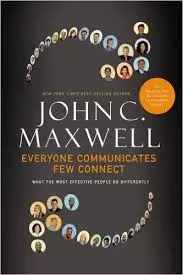
Everyone Communicates, Few Connect: What the Most Effective People Do Differently
by John C. Maxwell
I once heard John Maxwell refer to his wonderful book, The 17 Essential Qualities of a Team Player: Becoming the Kind of Person Every Team Wants, as a "picture book" to help the reader identify a team player.
I have read many of John's books, so let me take the "picture book" idea one step further - these books are not so much written to be read as they are written to be used! You don't need to read this book to find the key lessons and begin to apply them.
What does it mean to "connect" with someone – whether it's one-on-one, a small group, or an audience? "Connecting is the ability to identify with people and relate to them in a way that increases your influence with them." (page 3)
While I agree that's a good definition, what's more important are the signs enabling you to know you HAVE connected with people – when you connect with people, you can sense several of the following (pages xii and xiii):
- Extra Effort
- Unsolicited Appreciation
- Unguarded Openness
- Increased Communication
- Enjoyable Experiences
- Emotional Bondedness
- Positive Energy
- Growing Synergy
- Unconditional Love
Like all of John's books, this one is highly structured – however, at least in this book, this high degree of structuring does not come through in the very brief table of contents:
Part I: Connecting Principles
1. Connecting Increases Your Influence in Every Situation
2. Connecting Is All About Others
3. Connecting Goes Beyond Words
4. Connecting Always Requires Energy
5. Connecting Is More Skill Than Natural Talent
Part II: Connecting Practices
6. Connectors Connect on Common Ground
7. Connectors Do the Difficult Work of Keeping It Simple
8. Connectors Create an Experience Everyone Enjoys
9. Connectors Inspire People
10. Connectors Live What They Communicate
My tip – use the table of contents to help diagnose WHERE you might not be connecting, turn to that chapter, flip through the chapter's pages, and use the headings and subheadings to find the topic which most speaks to your needs. For example, you might feel you have the right words, yet are not connecting effectively – turn to Chapter 3, "Connecting Goes Beyond Words," and you might find the following meets your needs:
- "When we try to communicate, we must include:
- Thought: something we know
- Emotion: something we feel
- Action: something we do" (page 49)
- "Nothing can happen through you until it happens to you." (page 51 - emphasis added)
That final bullet point is really what this entire book is about – you must FEEL something before you will DO something.
In Closing
Did you notice? A recurring point across ALL the books is finding a way to inject emotions into what you say, so you can better influence someone to think or act in a certain way. It really is true – Nothing Changes Until Somebody Feels Something.
If you're like me, your work day contains a lot of emails, phone calls, meetings, analyses, projects, and just getting things done. Even so, it IS possible to improve how you connect with clients and staff by looking for ways to inject emotion into your day-to-day tasks.
I have already begun to apply the concepts in these four books, and am starting to see the "first fruits" of my efforts. I wish you the same success as you read any – or, preferably, all – of these four fine books!
Oh, and be sure to sign up for the daily gapingvoid newsletter!
Sincerely,

Todd L. Herman






